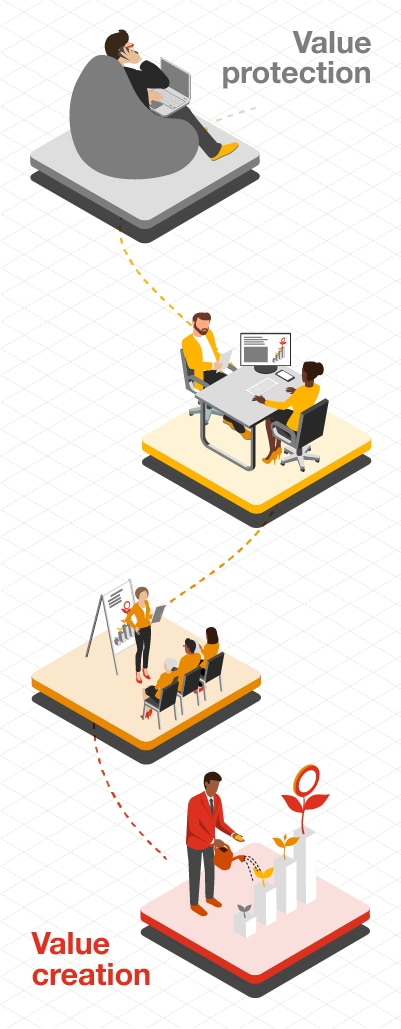

CSRD: Rest assured—there’s help
Navigate CSRD requirements confidently with assurance practitioners. Act now to deliver top-quality reports on time, and with confidence.
The pressure on companies to integrate sustainability into their broader organizational strategy is intensifying.
Investors tell usOpens in a new window they want to understand how companies incorporate environmental, social and governance (ESG)—i.e. sustainability—considerations into their strategic decision-making and prospects for creating long-term value. And regulators are taking notice. Take the European Union’s Corporate Sustainability Reporting Directive (CSRD), for example. It requires companies, including more than 1,000 in Canada, to disclose how their overall strategy addresses sustainability factors.
Other regulations are similarly forcing companies to integrate sustainability into their operations and reinvent business models. For example, Canada’s modern slavery rules—an important social commitment and reporting requirement for many companies—are prompting organizations to systematically rethink how they manage risks in their operations, supply chains and vendor relationships.
More broadly, climate change, social instability and other long-term megatrends are creating an imperative for companies to transform how they create, deliver and capture value. These forces are pushing businesses to integrate sustainability across their organization, using technology to power their performance and report credible data on their progress. Sustainability considerations are now important factors in corporate reporting, enterprise resource planning and organizational strategy—as well as a company’s long-term business resilience and enterprise value.
Integrating sustainability into corporate strategy is a critical step in a larger journey. It often starts with a focus on protecting value by managing sustainability-related risks, such as reputational damage. But as companies strategically integrate sustainability into their operations, they unlock new opportunities to create value and ultimately reinvent entire business modelsOpens in a new window.


As they transform, sustainability leaders create a virtuous circle. They comply with reporting and regulatory requirements with greater efficiency and accuracy by integrating with the business and financial and risk leaders and functions. They thoughtfully revisit their sustainability targets and objectives working with corporate strategy, the board and the executive team as a whole to create strategies and tactics that align the entire organization on what matters—to regulators, stakeholders and customers.
These leading companies also use technology to develop, integrate and execute their sustainability strategy. They capture metrics that matter, share and manage those at the action and decision level in the business, and use data to realize strategic objectives and course correct as needed. And many are adopting emerging technologies such as generative artificial intelligence to further improve their sustainability performance.
As you look to embed sustainability into your broader organizational strategy, it can be tempting to start by rethinking your own strategy or operating model as a first step. Resist this impulse. Instead, look outside your company by focusing on your stakeholders’ needs and the underlying megatrends and scenarios that can change your stakeholders’ demands or trigger new requirements. Changes to strategy, operating model and targets and metrics should be rooted deeply in what matters to your organization and translated to those parts of the organization that will drive your performance in those areas.
So, how can organizations achieve the greatest impact through their sustainability investments? Your next move depends on where your organization is on its sustainability journey. But several fundamental steps can help you integrate sustainability into corporate strategy:
Asking your customers, regulators, investors and other important stakeholders what matters to them—and why—helps refine your existing sustainability strategy, prioritize risks and opportunities and better align sustainability objectives with corporate goals.
This exercise can also uncover overlooked value-creation opportunities. For example, our Voice of the Consumer survey highlighted the importance of data security to Canadian shoppers. We found retailers trusted with their customers’ data can provide more personalized services that help them capture market share. This turns cybersecurity—an important governance factor—from a value protection measure into a path to value creation.
Where do you want your company positioned on each material issue? Do you want to be an industry leader? Or can you meet your stakeholders’ expectations by simply keeping pace with the sector average? Benchmarking your organization against your peers helps you answer these questions, understand your starting point and explore your readiness to meet your ambitions by implementing the required changes and investments.
Start by developing possible scenarios based on the macro-level and industry-specific uncertainties most relevant to your business. Then, zoom in on the impacts to your business, including stress testing your assumptions and strategy. For example, what are the different paths to reducing your carbon emissions and achieving your 2030 targets? What are the financial implications of each option? What are the competing or complementary needs of other parts of the business that would benefit from an integrated approach?
Creating criteria for evaluating various sustainability initiatives helps you narrow your efforts and create business cases for new investments. Once you’ve pinpointed your priorities, you can develop focused implementation roadmaps to achieve your desired level of ambition. Considering high-level data and technology requirements, capital allocation decisions and operational factors help connect your sustainability efforts closer to corporate strategy.
Some companies already embed corporate strategy into their sustainability plans. In these cases, companies can accelerate their progress by considering how to link their sustainability investments and efforts to their larger organizational structure and operations.

Are your front-line employees aware of your company’s sustainability goals? More importantly, do they know how their day-to-day activities affect their organization’s progress?
Nearly one-third (32%) of Canadian employees surveyed for our 2024 Global Workforce Hopes and Fears reportOpens in a new window said new climate-related technologies or advancements in their field will require them to learn new skills. Reviewing your workplace culture and employee behaviours helps align your business activities with your sustainability targets. And by understanding what matters most to your people, you can equip them to navigate an ever-changing business landscape—turning complex sustainability concepts into concrete steps that everyone can take to contribute to your short-, medium- and long-term commitments.
Consider the example of a mining company with an emissions-reduction target. It can incentivize field operators and managers by giving them specific carbon targets based on a strategy-led bottom-up analysis—much like the financial targets they’re already responsible for meeting—and access to metrics and dashboards that show the implications of their decisions on their company’s carbon footprint.
Sustainability considerations are rewriting job descriptions in the C-suite. Executive leadership of sustainability initiatives is crucial for long-term value creation—as well as for meeting corporate sustainability objectives.
By rethinking their sustainability governance structure, organizations can bring together the diverse perspectives and capabilities needed to integrate sustainability into their organization. For example, consider the CFO’s experience in establishing robust controls. Or the risk function’s ability to quantify sustainability impacts on the organization. Or the significant role of IT professionals in designing and managing a company’s sustainability system architecture.
By now, most companies—and indeed, most people—understand that sustainability is more than a regulatory compliance issue. Integrating sustainability factors into corporate strategy, business operations and decision making can also enhance your company’s enterprise value, capture opportunities and realize an even deeper return on investments. Doing so can improve your brand reputation, help attract and retain talent, lower the cost of capital and let you allocate resources more efficiently and effectively.
Importantly, it also builds trust with your stakeholders by helping you demonstrate tangible, thoughtful progress toward your strategic objectives—making your sustainability actions add up to more.
Sign up to receive our latest ESG thought leadership straight to your inbox
Learn how we can help you redefine what’s possible


Navigate CSRD requirements confidently with assurance practitioners. Act now to deliver top-quality reports on time, and with confidence.


Our survey yields consumer insights on building trust and loyalty through an omnichannel retail strategy, based on the latest retail trends in Canada.


Canada issues draft sustainability reporting standards CSDS 1 and 2. Here’s what you need to know.


Today’s chief sustainability officers have a lot more on their plate than reducing emissions. To tackle it all, they can’t go it alone.

National Sustainability Strategy and Transformation Leader, Global Sustainability Leader for Enterprise Private Business, PwC Canada
Tel: +1 587 226 1303
